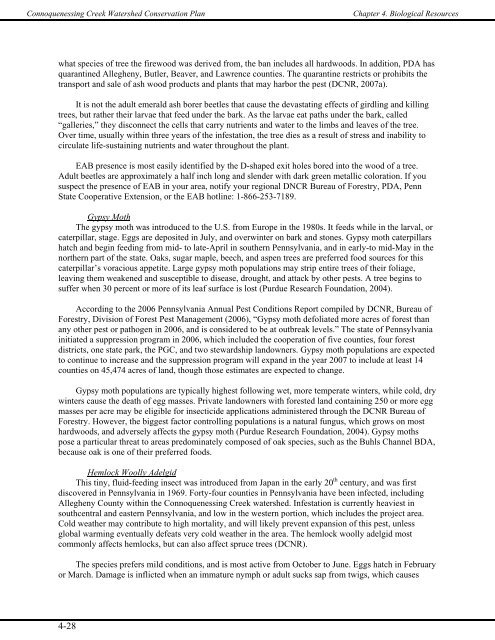CHAPTER 4 - Western Pennsylvania Conservancy
CHAPTER 4 - Western Pennsylvania Conservancy
CHAPTER 4 - Western Pennsylvania Conservancy
Create successful ePaper yourself
Turn your PDF publications into a flip-book with our unique Google optimized e-Paper software.
Connoquenessing Creek Watershed Conservation Plan<br />
Chapter 4. Biological Resources<br />
what species of tree the firewood was derived from, the ban includes all hardwoods. In addition, PDA has<br />
quarantined Allegheny, Butler, Beaver, and Lawrence counties. The quarantine restricts or prohibits the<br />
transport and sale of ash wood products and plants that may harbor the pest (DCNR, 2007a).<br />
It is not the adult emerald ash borer beetles that cause the devastating effects of girdling and killing<br />
trees, but rather their larvae that feed under the bark. As the larvae eat paths under the bark, called<br />
“galleries,” they disconnect the cells that carry nutrients and water to the limbs and leaves of the tree.<br />
Over time, usually within three years of the infestation, the tree dies as a result of stress and inability to<br />
circulate life-sustaining nutrients and water throughout the plant.<br />
EAB presence is most easily identified by the D-shaped exit holes bored into the wood of a tree.<br />
Adult beetles are approximately a half inch long and slender with dark green metallic coloration. If you<br />
suspect the presence of EAB in your area, notify your regional DNCR Bureau of Forestry, PDA, Penn<br />
State Cooperative Extension, or the EAB hotline: 1-866-253-7189.<br />
Gypsy Moth<br />
The gypsy moth was introduced to the U.S. from Europe in the 1980s. It feeds while in the larval, or<br />
caterpillar, stage. Eggs are deposited in July, and overwinter on bark and stones. Gypsy moth caterpillars<br />
hatch and begin feeding from mid- to late-April in southern <strong>Pennsylvania</strong>, and in early-to mid-May in the<br />
northern part of the state. Oaks, sugar maple, beech, and aspen trees are preferred food sources for this<br />
caterpillar’s voracious appetite. Large gypsy moth populations may strip entire trees of their foliage,<br />
leaving them weakened and susceptible to disease, drought, and attack by other pests. A tree begins to<br />
suffer when 30 percent or more of its leaf surface is lost (Purdue Research Foundation, 2004).<br />
According to the 2006 <strong>Pennsylvania</strong> Annual Pest Conditions Report compiled by DCNR, Bureau of<br />
Forestry, Division of Forest Pest Management (2006), “Gypsy moth defoliated more acres of forest than<br />
any other pest or pathogen in 2006, and is considered to be at outbreak levels.” The state of <strong>Pennsylvania</strong><br />
initiated a suppression program in 2006, which included the cooperation of five counties, four forest<br />
districts, one state park, the PGC, and two stewardship landowners. Gypsy moth populations are expected<br />
to continue to increase and the suppression program will expand in the year 2007 to include at least 14<br />
counties on 45,474 acres of land, though those estimates are expected to change.<br />
Gypsy moth populations are typically highest following wet, more temperate winters, while cold, dry<br />
winters cause the death of egg masses. Private landowners with forested land containing 250 or more egg<br />
masses per acre may be eligible for insecticide applications administered through the DCNR Bureau of<br />
Forestry. However, the biggest factor controlling populations is a natural fungus, which grows on most<br />
hardwoods, and adversely affects the gypsy moth (Purdue Research Foundation, 2004). Gypsy moths<br />
pose a particular threat to areas predominately composed of oak species, such as the Buhls Channel BDA,<br />
because oak is one of their preferred foods.<br />
Hemlock Woolly Adelgid<br />
This tiny, fluid-feeding insect was introduced from Japan in the early 20 th century, and was first<br />
discovered in <strong>Pennsylvania</strong> in 1969. Forty-four counties in <strong>Pennsylvania</strong> have been infected, including<br />
Allegheny County within the Connoquenessing Creek watershed. Infestation is currently heaviest in<br />
southcentral and eastern <strong>Pennsylvania</strong>, and low in the western portion, which includes the project area.<br />
Cold weather may contribute to high mortality, and will likely prevent expansion of this pest, unless<br />
global warming eventually defeats very cold weather in the area. The hemlock woolly adelgid most<br />
commonly affects hemlocks, but can also affect spruce trees (DCNR).<br />
The species prefers mild conditions, and is most active from October to June. Eggs hatch in February<br />
or March. Damage is inflicted when an immature nymph or adult sucks sap from twigs, which causes<br />
4-28














